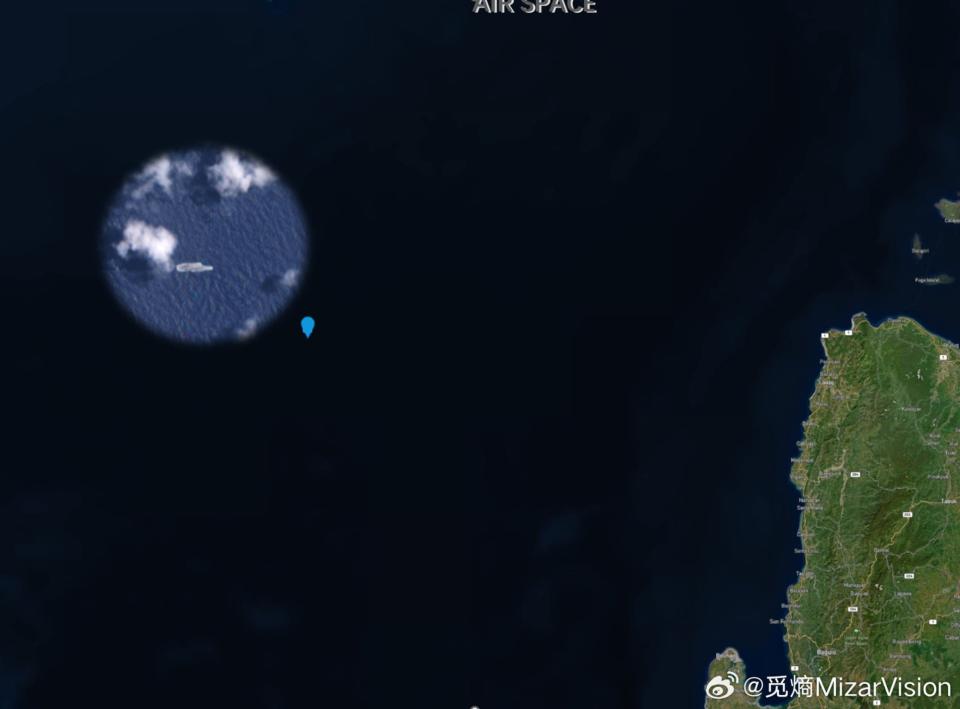A Chinese aircraft carrier spotted near the Philippines. What does it mean?
A Chinese aircraft carrier reportedly patrolled the waters off the Philippines in an operation that observers say was a message to Manila and Washington.
The aircraft carrier is widely believed to be the Shandong, China's most advanced aircraft carrier in service.
It was detected sailing northwest from the Philippine island of Luzon in the South China Sea, according to a satellite image provided on Wednesday by MizarVision, a Shanghai-based technology and intelligence company.
Do you have questions about the biggest topics and trends from around the world? Get the answers with SCMP Knowledge, our new platform of curated content with explainers, FAQs, analyses and infographics brought to you by our award-winning team.
European satellite Sentinel-1 also detected the aircraft carrier patrolling the waters on the same day.
According to Sentinel-2, an aircraft carrier last week left Sanya, Hainan province, the homeport of the Shandong carrier.
Neither the Chinese nor the Philippine defence ministry commented on the image. They also did not respond to requests from the Post for comment.

The Shandong was detected sailing northwest from the Philippine island of Luzon in the South China Sea, according to a satellite image provided by MizarVision, a Shanghai-based technology and intelligence company. Photo: Weibo alt=The Shandong was detected sailing northwest from the Philippine island of Luzon in the South China Sea, according to a satellite image provided by MizarVision, a Shanghai-based technology and intelligence company. Photo: Weibo>
Ni Lexiong, a defence professor in the department of political science at Shanghai University of Political Science and Law, said the Shandong's passage was meant to be a deterrent to Manila and Washington, and underline "China's determination to protect territorial sea sovereignty" amid tensions over the Second Thomas Shoal.
The People's Liberation Army has stepped up drills in the South China Sea in recent months. Last week, four navy ships - two destroyers, a frigate, and a supply vessel - were spotted near the southwestern Philippine island of Palawan in the South China Sea.
Chester Cabalza, president and founder of International Development and Security Cooperation, a Manila-based think tank, said the carrier's patrol was an example of "performative politics" by Beijing that could become a frequent event.
If so, it "would mean that there is a red flag on their national security", he said, adding that "once we see massive military force, that means that Beijing is preparing for a war".
Former PLA instructor Song Zhongping said the aircraft carrier may head to the Western Pacific Ocean later and rendezvous with four navy ships near the Philippine island of Palawan.
"The Shandong can go to all of these places, including waters to the east of Taiwan, the Western Pacific Ocean, and all of the South China Sea. Aircraft carriers usually travel with battleships on the side to protect them, so it's normal if [the Shandong and the navy ships] converge."
Tensions between China and the Philippines have escalated over the Second Thomas shoal, known as Renai Jiao in China and Ayungin Shoal in the Philippines.
In June, a Chinese coastguard ship intercepted several Philippine Navy vessels on a routine resupply mission to troops stationed at a decaying former warship on the shoal.
Chinese coastguard crew members armed with knives, machetes, and other weapons intercepted the Philippine troops, according to footage of the incident, resulting in a Filipino losing a thumb.
While there is hope of dialogue - Philippine Foreign Secretary Enrique Manalo said last week that Manila was working on holding talks in July with Beijing over their South China Sea differences - the Philippines is fortifying its relationship with treaty partner the United States.
The US deployed the mid-range Typhon missile system in the Philippines last month.
The system can launch SM-6 missiles with a range of up to 370km (230 miles) and cruise missiles that can carry conventional or nuclear warheads and have a range of up to 2,500km, according to the Washington-based Centre for Strategic and International Studies.
And a year ago the Philippines agreed to give the US access to four more of its military bases.
Ni, from Shanghai, said the Shandong's patrol might also be a direct response to the US-led Rimpac exercise, which started on Thursday.
The Rim of the Pacific exercise is the world's biggest international maritime military drill, and will take place near Hawaii until August. One of the major focuses this year is an exercise to sink the USS Tarawa, a 40,000-tonne retired amphibious assault ship. China is the only US competitor in the Asia-Pacific that has a comparable warship.
Last year, the Shandong's centre of attention was Taiwan, with the vessel conducting offshore drills neat the island in April and September.
This article originally appeared in the South China Morning Post (SCMP), the most authoritative voice reporting on China and Asia for more than a century. For more SCMP stories, please explore the SCMP app or visit the SCMP's Facebook and Twitter pages. Copyright © 2024 South China Morning Post Publishers Ltd. All rights reserved.
Copyright (c) 2024. South China Morning Post Publishers Ltd. All rights reserved.

 Yahoo Finance
Yahoo Finance 